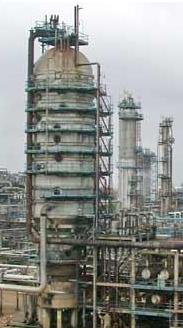Vacuum distillation

A vacuum distillation is a distillation under reduced pressure ( vacuum ). At low pressure, the boiling point of the liquids to be separated is reduced. Vacuum distillation makes it possible to separate substances that would decompose at higher temperatures. It is therefore used as a gentle separation process, for. B. to extract vegetable essences or to separate long-chain hydrocarbons in the oil refinery .
Distillation products
The products of vacuum distillation are divided into vacuum products and vacuum distillates. Operation can be carried out continuously, as in oil refining, or discontinuously. Furthermore, as with the atmospheric distillation methods, a distinction can be made between simple vacuum distillation (cocurrent process, mostly discontinuous, vacuum distillate overhead, possibly collectible in several fractions) and vacuum rectification ( countercurrent process , discontinuous and continuous). The vacuum sump product is the part that does not evaporate under the given conditions (temperature, pressure) (see below). The vacuum distillate is drawn off as the top product - similar to "simple" atmospheric distillation . In continuous processes, the vacuum distillates are withdrawn as side cuts (fractions) (as in continuous atmospheric rectification). Vacuum columns usually contain so-called structured packings as internals , no exchange trays .
Vacuum distillation in the processing of petroleum
The petroleum processing applies when the atmospheric distillation at temperatures around 370 ° C. A further increase in temperature would lead to decomposition ( cracking ) of the crude oil components. The bottom of the atmospheric column, the atmospheric residue (Long Residue, LR), is therefore fed to a vacuum distillation (more precisely, a continuous fractional vacuum rectification) and divided into vacuum gas oil (s) and vacuum residue (Short Residue, SR) . The vacuum distillation (coarse vacuum , 10–30 mbar) takes place - compared to the atmospheric distillation - at a slightly higher temperature. The vacuum gas oil (VGO) is normally fed to an FCC system or a hydrocracker (HCU) , where light hydrocarbons are produced. The vacuum residue is used directly as bitumen , mixed with heavy oil or heating oil , or also cracked to light hydrocarbons in thermal cracking systems . The vacuum residue can also be extracted in a solvent deasphalting plant (SDA) and separated into the components deasphalted oil (DAO) and asphalt.
Fractional vacuum distillation with several (narrow) fractions is used in the production of so-called base oils for the production of lubricating oils .
Mild vacuum (300 to 500 mbar) is used when separating high-boiling Nafta components (e.g. C8 / C9 separation) in order to lower the temperature level in the distillation process. In this way, energetically more favorable heat transfer media can be used (e.g. medium pressure steam / approx. 20 bar instead of high pressure steam / approx. 40 bar).

